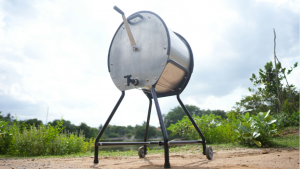While we as a species are heavily dependent on the natural ecosystem for food, clothing, shelter and other basic needs, man-made processes have polluted the environment.
For this reason, designers, scientists and researchers are developing new goods and methods of production that aim to reduce the severe impact on the world’s natural resources.
Have a look at some of the latest, innovative products that maximise usage and minimise waste while drawing upon more sustainable materials.
POC Packaging by Felix Pöttinger

Designed by Felix Pöttinger, this biodegradable food packaging is made from dried seagrass fibres and bound together in a cellulose-based substance extracted from the same plant.
It is not only completely biodegradable but also boasts antibacterial properties that help keep dry food fresh.
Designed as part of Pöttinger’s Design Products masters degree, the German believes that his material could be easily integrated into traditional industrial methods.
“It's a natural waste material, and past research showed that it is highly resistant against mould,” the designer told Dezeen.
“I'm only using the dead seagrass fibres that appear on the beaches of the Mediterranean coast, so there is no industrial harvesting process to harm the population of the seagrass or any living being.”
Chitosan biodegradable plastic

A team of Egyptian researchers at the country’s Nile University has developed a unique alternative to plastic by turning dried shrimp cells into thin films of biodegradable plastic for eco-friendly grocery bags and packaging.
By utilising chitosan – a material found in the shells of many crustaceans – they are able to produce a clear, thin plastic prototype.
When you consider the fact that Egypt imports some 3500000 kilogrammes of shrimp, and is left with 1000000 kilogrammes of shrimp shell waste. This development could help drastically reduce issues of waste as well as plastic pollution.
“If commercialised, this could really help us decrease our waste…and it could help us improve our food exports because the plastic has antimicrobial and antibacterial properties,” says Professor Irene Samy, head of the Nile University research team.
Beleaf Chair by Šimon Kern

From Slovakian designer Šimon Kern comes the Beleaf Chair. Designed to make the most out of natural waste, the chair is made from a mixture of fallen leaves and bio-resin made from leftover cooking oil.
After being pressed and set in a mould, the material was sanded and attached to a steel frame.
The chair is intended to last for hundreds of years. Kern is still perfecting the process, experimenting with more ergonomic and biodegradable versions of the chair.
"If it gets damaged we just put it under the tree, where it disappears into the soil and fertilises a tree," Kern says. "Then we pick the fallen leaves once again, and make a new seat."
Nike Wearable Air Max Shoebox

In partnership with Taiwanese architect and engineer Arthur Huang, Nike has developed distinctive packaging for their iconic Air Max sneaker that is made from recycled drink containers and lids.
Released as part of the brand's annual Air Max Day, the shoebox was designed to double up as a backpack and utilises plastics originating from leftover consumer packaging. Its production method also employs no added chemicals.
"What we do here is very simple, we try to use the stuff we throw away and turn that into the most sustainable way with the least carbon footprint to create a new product," Huang has said about the collaboration. "It's all about turning pollution into a solution for the future."






